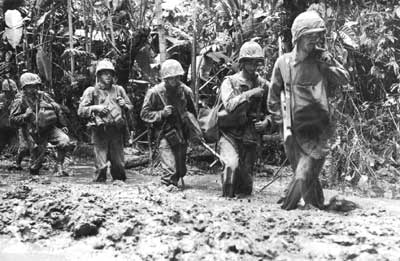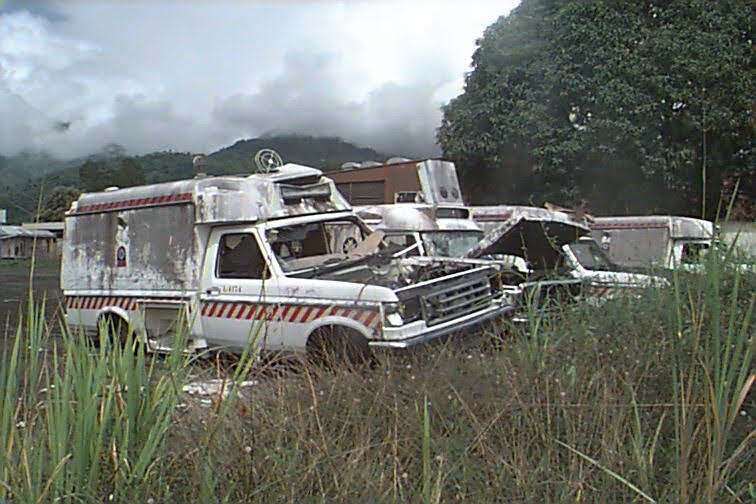|
John Bika
John Bika (died 11 September 1989) was a Papua New Guinea and Bougainvillean politician. Bika was the North Solomons Provincial Assembly MP for Nasioi-Pirung and Minister for Commerce and Liquor Licensing in the provincial administration of North Solomons Premier Joseph Kabui in 1989, at the beginning of the Bougainville Civil War. He had chaired a provincial committee into the issue of Bougainvillean secession that had recommended that Bougainville remain within Papua New Guinea but with increased autonomy. He was assassinated at his home in Toboroi village by Bougainville Revolutionary Army militants on 11 September 1989. He had been due to fly to Port Moresby the following day as one of the signatories to a proposed "peace package" to end the conflict. Bika was shot dead in front of his wife, Helen Bika, and was survived by five children. In the aftermath of the assassination, the Papua New Guinean government announced a 200,000 kina reward for the capture of BRA leader Francis ... [...More Info...] [...Related Items...] OR: [Wikipedia] [Google] [Baidu] |
Papua New Guinea
Papua New Guinea (abbreviated PNG; , ; tpi, Papua Niugini; ho, Papua Niu Gini), officially the Independent State of Papua New Guinea ( tpi, Independen Stet bilong Papua Niugini; ho, Independen Stet bilong Papua Niu Gini), is a country in Oceania that comprises the eastern half of the island of New Guinea and its offshore islands in Melanesia (a region of the southwestern Pacific Ocean north of Australia). Its capital, located along its southeastern coast, is Port Moresby. The country is the world's third largest island country, with an area of . At the national level, after being ruled by three external powers since 1884, including nearly 60 years of Australian administration starting during World War I, Papua New Guinea established its sovereignty in 1975. It became an independent Commonwealth realm in 1975 with Elizabeth II as its queen. It also became a member of the Commonwealth of Nations in its own right. There are 839 known languages of Papua New Guinea, one of ... [...More Info...] [...Related Items...] OR: [Wikipedia] [Google] [Baidu] |
Bougainville Island
Bougainville Island (Tok Pisin: ''Bogenvil'') is the main island of the Autonomous Region of Bougainville, which is part of Papua New Guinea. It was previously the main landmass in the German Empire-associated North Solomons. Its land area is . The population of the whole province, including nearby islets such as the Carterets, is approximately 300,000 (2019 census). The highest point is Mount Balbi, on the main island, at . The much smaller Buka Island, , lies to the north, across the wide Buka Strait. Even though the strait is narrow, there is no bridge across it, but there is a regular ferry service between the key settlements on either side. The main airport (or airstrip) in the north is in the town of Buka. Bougainville is the largest island in the Solomon Islands archipelago. Most of the islands in this archipelago (which are primarily concentrated in the southern and eastern portions of it) are part of the politically independent Solomon Islands. Two of these islands ... [...More Info...] [...Related Items...] OR: [Wikipedia] [Google] [Baidu] |
Joseph Kabui
Joseph Canisius Kabui (1954 – 7 June 2008) was a secessionist leader and the first President of the Autonomous Region of Bougainville, off the coast of Papua New Guinea, from 2005 to 2008. He was also the leader of the Bougainville People's Congress."Bougainville president Kabui dies" theage.com.au, 7 June 2008. Kabui was a commander in the during the war in Bougainville in the 1990s. In June 2005, after the island gained autonomy within Papua New Guinea, he was ... [...More Info...] [...Related Items...] OR: [Wikipedia] [Google] [Baidu] |
Bougainville Civil War
The Bougainville conflict, also known as the Bougainville Civil War, was a multi-layered armed conflict fought from 1988 to 1998 in the North Solomons Province of Papua New Guinea (PNG) between PNG and the secessionist forces of the Bougainville Revolutionary Army (BRA), and between the BRA and other armed groups on Bougainville. The conflict was described by Bougainvillean President John Momis as the largest conflict in Oceania since the end of World War II in 1945, with an estimated 15,000–20,000 Bougainvilleans dead, although lower estimates place the toll at around 1,000–2,000. Hostilities concluded under the Bougainville Peace Agreement in 1998. The national (PNG) government agreed to the founding of the Autonomous Bougainville Government and to certain rights and authorities which the autonomous government would have over what became known as Bougainville Province, which includes outlying small islands in addition to Bougainville Island itself. Historical background ( ... [...More Info...] [...Related Items...] OR: [Wikipedia] [Google] [Baidu] |
Bougainville Revolutionary Army
The Bougainville Revolutionary Army (BRA) was a secessionist group formed in 1988 by Bougainvilleans seeking independence from Papua New Guinea (PNG). The leader of the BRA was Francis Ona who led the BRA against the Papua New Guinea Defence Force during the violent 10 year conflict. Not all BRA members agreed to the Peace Treaty and boycotted it, and have held out in an official no-go zone, protected by members of the Meekamui Defence Force, currently commanded by Moses Pepino. BRA leaders argued that Bougainville is ethnically part of the Solomon Islands and has not profited from the extensive mining that has occurred on the island. In 1989, BRA leaders proclaimed Bougainville independent from PNG and established the Autonomous Bougainville Government (ABG). As a result, fighting between the BRA and the PNG Defence Force, with support from Australia, escalated. In January 1991, the Honiara Declaration [...More Info...] [...Related Items...] OR: [Wikipedia] [Google] [Baidu] |
Francis Ona
Francis Ona (c. 1953 – 24 July 2005) was a Bougainville secessionist leader who led an uprising against the Government of Papua New Guinea as part of the Bougainville Civil War. He and his followers were concerned about the environmental and social effects of the operation of the Panguna mine by Bougainville Copper, a subsidiary of Rio Tinto Group. On 17 May 1990, Ona declared the independence of the Republic of Me'ekamui."The Bougainville independence referendum: Assessing the risks and challenges before, during and after the referendum" by Jo Woodbury January 2015; Commonwealth of Australia It was not recognised internationally. In May 2004 Ona proclaimed himself "King of Me'ekamui." While resisting the peace process and 2005 elections, Ona mostly stayed in a safe haven, where his BRA forces controlled territory. He died of malaria in his village. Secessionist leader Ona was at one time employed by Bougainville Copper at the mine, but he became increasingly critical of its ... [...More Info...] [...Related Items...] OR: [Wikipedia] [Google] [Baidu] |
Autonomous Bougainville Government
The Autonomous Bougainville Government (ABG; tpi, Otonomos Bogenvil Gavman) is the government of the Autonomous Region of Bougainville, Papua New Guinea. Structure The Constitution of Bougainville specifies that the Autonomous Bougainville Government shall consist of three branches: * Executive – the President of the Autonomous Region of Bougainville, who chairs the Bougainville Executive Council * Legislative – the Bougainville House of Representatives (39 elected members and 2 ex officio members). * Judicial – the Bougainville Courts, including a Supreme Court and High Court. History The government was established in 2000 following a peace agreement between the government of Papua New Guinea and the Bougainville Revolutionary Army (BRA) a guerrilla movement. Elections for the first autonomous government were held in May and June 2005; Joseph Kabui was elected president, with Joseph Watawi selected by the House of Representatives as vice-president. A non-binding ... [...More Info...] [...Related Items...] OR: [Wikipedia] [Google] [Baidu] |
People From Bougainville Island
A person ( : people) is a being that has certain capacities or attributes such as reason, morality, consciousness or self-consciousness, and being a part of a culturally established form of social relations such as kinship, ownership of property, or legal responsibility. The defining features of personhood and, consequently, what makes a person count as a person, differ widely among cultures and contexts. In addition to the question of personhood, of what makes a being count as a person to begin with, there are further questions about personal identity and self: both about what makes any particular person that particular person instead of another, and about what makes a person at one time the same person as they were or will be at another time despite any intervening changes. The plural form "people" is often used to refer to an entire nation or ethnic group (as in "a people"), and this was the original meaning of the word; it subsequently acquired its use as a plural form of ... [...More Info...] [...Related Items...] OR: [Wikipedia] [Google] [Baidu] |
Assassinated Papua New Guinean Politicians
Assassination is the murder of a prominent or important person, such as a head of state, head of government, politician, world leader, member of a royal family or CEO. The murder of a celebrity, activist, or artist, though they may not have a direct role in matters of the state, may also sometimes be considered an assassination. An assassination may be prompted by political and military motives, or done for financial gain, to avenge a grievance, from a desire to acquire fame or notoriety, or because of a military, security, insurgent or secret police group's command to carry out the assassination. Acts of assassination have been performed since ancient times. A person who carries out an assassination is called an assassin or hitman. Etymology The word ''assassin'' may be derived from '' asasiyyin'' (Arabic: أَسَاسِيِّين, ʾasāsiyyīn) from أَسَاس (ʾasās, "foundation, basis") + ـِيّ (-iyy), meaning "people who are faithful to the found ... [...More Info...] [...Related Items...] OR: [Wikipedia] [Google] [Baidu] |
1989 Deaths
File:1989 Events Collage.png, From left, clockwise: The Cypress Street Viaduct, Cypress structure collapses as a result of the 1989 Loma Prieta earthquake, killing motorists below; The proposal document for the World Wide Web is submitted; The Exxon Valdez oil tanker runs aground in Prince William Sound, Alaska, causing a large Exxon Valdez oil spill, oil spill; The Fall of the Berlin Wall begins the downfall of Communism in Eastern Europe, and heralds German reunification; The United States United States invasion of Panama, invades Panama to depose Manuel Noriega; The Singing Revolution led to the independence of the Baltic states of Estonia, Latvia, and Lithuania from the Soviet Union; The stands of Hillsborough Stadium in Sheffield, Yorkshire, where the Hillsborough disaster occurred; 1989 Tiananmen Square protests and massacre, Students demonstrate in Tiananmen Square, Beijing; many are killed by forces of the Chinese Communist Party., 300x300px, thumb rect 0 0 200 200 1989 Loma ... [...More Info...] [...Related Items...] OR: [Wikipedia] [Google] [Baidu] |
Oceania Politicians Assassinated In The 1980s
Oceania (, , ) is a region, geographical region that includes Australasia, Melanesia, Micronesia, and Polynesia. Spanning the Eastern Hemisphere, Eastern and Western Hemisphere, Western hemispheres, Oceania is estimated to have a land area of and a population of around 44.5 million as of 2021. When compared with (and sometimes described as being one of) the continents, the region of Oceania is the smallest in land area and the list of continents and continental subregions by population, second least populated after Antarctica. Its major population centres are Sydney, Melbourne, Brisbane, Perth, Auckland, Adelaide, Honolulu, and Christchurch. Oceania has a diverse mix of economies from the developed country, highly developed and globally competitive market economy, financial markets of Australia, French Polynesia, Hawaii, Hawaii, New Caledonia, and New Zealand, which rank high in quality of life and Human Development Index, to the much least developed countries, less developed ... [...More Info...] [...Related Items...] OR: [Wikipedia] [Google] [Baidu] |


_1938.jpg)

